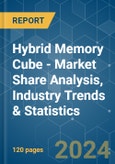The Hybrid Memory Cube Market size is estimated at USD 1.45 billion in 2024, and is expected to reach USD 2.92 billion by 2029, growing at a CAGR of 15.11% during the forecast period (2024-2029).
A hybrid memory cube (henceforth called HMC) is a revolutionary technology that signifies a paradigm shift from current memory architectures.
This product will be delivered within 2 business days.
A hybrid memory cube (henceforth called HMC) is a revolutionary technology that signifies a paradigm shift from current memory architectures.
Key Highlights
- The significant factors driving the Hybrid Memory Cube (HMC) market expansion are the rising number of server farms and employees, the rising shipments of business equipment, and the rising number of assembling activities in the venture stockpiling and consumer hardware sectors. The market for HMC and HBM is expanding due to factors like the rising need for high bandwidth, rising AI use, and developing trends in electronic device downsizing.
- HMC is redefining memory by enabling advancements that can replace conventional DRAM-based systems. It is setting a new standard in the memory market that matches the computing speeds realized by existing systems (such as CPU).
- HMC dramatically improves bandwidth and performance by breaking through the memory wall. The architecture of HMC is exponentially more efficient than current memory architectures, utilizing 70% less energy per bit than current DRAM technologies. For instance, Synopsys Inc. announced the availability of its next-generation Verification IP (VIP) for Micron's Hybrid Memory Cube (HMC) architecture. This can enable Micron's HMC with ease of use, fast integration, and optimum performance, resulting in accelerated verification closure.
- The ever increasing demand for mobility and the rising impact of cloud services is expected to further create demand for HMC solutions, owing to their higher bandwidth, which boosts the capability of networking systems to match line speed performance.
- The COVID-19 pandemic impacted worldwide sectors, and the global economy was negatively impacted in 2020. Many industries, such as semiconductors, consumer electronics, travel, and automobile, were severely impacted due to the pandemic, which negatively impacted the hybrid memory cube market.
Hybrid Memory Cube Market Trends
Networking and Telecommunication Segment is Expected to Register a Significant Growth
- The global telecommunication sector is continuously transitioning as infrastructure improvements to broadband and mobile technologies continue.
- Hybrid memory cubes are increasingly used for high-performance computing (HPC), which can be termed as the set of distributed and parallelization techniques used to connect computing units to perform more complex tasks faster.
- Edge computing networks and telecommunication technologies support information transmission over distances via., connected and distributed communication devices.
- Rapid innovations in transmitting, switching, processing, analyzing, and retrieving information are essential for the success of various emerging telecommunication technologies, and this is likely to indirectly influence the growth of the HMC market over the forecast period. The advent of 5G is expected to boost the HMC market.
Asia-Pacific is Expected to Witness Fastest CAGR
- The region's industries, such as retail, healthcare, IT, and telecommunication, need advanced and fast data processing systems due to the increasing consumer base and data traffic. Moreover, China wishes to establish a world-class IC design unit in applications, such as telecommunications, IoT, big data, and cloud computing industries, which is expected to further boost the HMC market.
- The enormous amount of data generated through the connected devices and the emergence of Big Data applications have put intense pressure on the data center memory systems and capacity, making the companies look for solutions to the problem. HMCs have a huge potential that could reduce not only the workload but also increase the performance and reduce power consumption by the data centers.
- The development of internet infrastructure in Asia-Pacific leads to the employment of modular data centers in this region. Therefore, Asia-Pacific companies of all sizes and industries are embracing the digital revolution. It is also driving data center providers and users to continuously increase their investment in the construction and services of modular data centers. Due to these significant measures, Asia-Pacific is expected to account for the highest growth rate of 58.57% over the forecast period.
Hybrid Memory Cube Industry Overview
The competitive rivalry among the players in the hybrid memory cube market is high due to the presence of many major players. Some major players include Micron Technologies, Samsung, Intel, Fujitsu, and many more. The innovations brought about by these players in their products and their ability to introduce a new product in the market by forecasting the needs of their consumers has enabled them to gain a competitive advantage over other players. Hefty investments in research and development, strategic partnerships, and mergers and acquisitions in the field of HMC have enabled the companies to capture a significant market share.- January 2023 - Aerospike enabled businesses to make real-time or nearly real-time decisions with the help of its modern data platform, which can handle globally resilient applications, function at an infinite scale, and provide predictable performance and cost-effectiveness.
Additional Benefits:
- The market estimate (ME) sheet in Excel format
- 3 months of analyst support
This product will be delivered within 2 business days.
Table of Contents
1 INTRODUCTION
4 MARKET DYNAMICS
5 MARKET SEGMENTATION
6 COMPETITIVE LANDSCAPE
Companies Mentioned (Partial List)
A selection of companies mentioned in this report includes, but is not limited to:
- Micron Technologies Inc.
- Intel Corporation
- Xilinx Inc.
- Fujitsu Ltd.
- Semtech Corporation
- Open Silicon Inc.
- ARM Holdings PLC
- Samsung Electronics Co. Ltd.
- IBM Corporation
- Altera Corporation
Methodology

LOADING...










